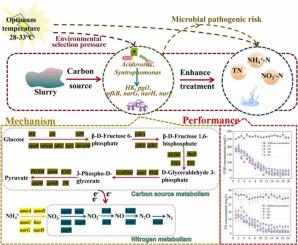当前位置:
X-MOL 学术
›
Process Saf. Environ. Prot.
›
论文详情
Our official English website, www.x-mol.net, welcomes your feedback! (Note: you will need to create a separate account there.)
The operating temperature affects the efficiency and pathogenic risk of wastewater treatment enhanced by slurry
Process Safety and Environmental Protection ( IF 6.9 ) Pub Date : 2024-06-14 , DOI: 10.1016/j.psep.2024.06.051 Heng Wu , Tianyu Yang , Bingbing Huang , Bingxi Zhu , Zhilin Xing , Guoqiang Zhan
Process Safety and Environmental Protection ( IF 6.9 ) Pub Date : 2024-06-14 , DOI: 10.1016/j.psep.2024.06.051 Heng Wu , Tianyu Yang , Bingbing Huang , Bingxi Zhu , Zhilin Xing , Guoqiang Zhan

|
The insufficient availability of carbon sources in low carbon source wastewater has consistently hampered the nitrogen removal efficiency. This study explored the potential of using anaerobic digested slurry supernatant as an additional carbon source and examined the cost-effective temperature range. The results demonstrated that wastewater treatment within the temperature range of 28 °C to 38 °C could meet the discharge standards set by wastewater treatment plants. However, at 38 °C, the nitrogen-to-carbon consumption ratio decreased to 0.18 g N/g COD. Mechanistic analysis revealed that both excessively high and low temperatures reduced the diversity of microbial communities and influenced the composition of the microbial community through environmental selective pressures. , , and were identified as the dominant genera for nitrogen removal at the temperature of 38 °C, 33 °C, 28 °C, and 23 °C, respectively. Furthermore, high temperature enhanced nitrogen removal performance by promoting microbial activity, microbial transmembrane substance transport process, and the abundance of key genes () at 38 °C. Importantly, factor score analysis confirmed that the risk of microbial pathogenicity was relatively low at 28 °C. This work provides valuable insights into the optimal temperature parameters and regulatory mechanisms for wastewater treatment systems utilizing slurry as a carbon source. It provides innovative ideas for the clean and safe development of low carbon source wastewater treatment technologies.
中文翻译:

操作温度影响浆液强化废水处理效率和致病风险
低碳源废水中碳源的可用性不足一直阻碍着脱氮效率。本研究探讨了使用厌氧消化浆液上清液作为额外碳源的潜力,并检查了具有成本效益的温度范围。结果表明,28℃~38℃温度范围内的废水处理可满足污水处理厂规定的排放标准。然而,在38℃时,氮碳消耗比下降至0.18gN/g COD。机理分析表明,过高和过低的温度都会降低微生物群落的多样性,并通过环境选择压力影响微生物群落的组成。 、 、 、 分别被确定为在38℃、33℃、28℃和23℃温度下脱氮的优势属。此外,38℃高温通过促进微生物活性、微生物跨膜物质转运过程和关键基因的丰度来增强脱氮性能。重要的是,因子评分分析证实,28℃时微生物致病性的风险相对较低。这项工作为利用浆料作为碳源的废水处理系统的最佳温度参数和调节机制提供了宝贵的见解。为低碳源废水处理技术的清洁、安全发展提供创新思路。
更新日期:2024-06-14
中文翻译:

操作温度影响浆液强化废水处理效率和致病风险
低碳源废水中碳源的可用性不足一直阻碍着脱氮效率。本研究探讨了使用厌氧消化浆液上清液作为额外碳源的潜力,并检查了具有成本效益的温度范围。结果表明,28℃~38℃温度范围内的废水处理可满足污水处理厂规定的排放标准。然而,在38℃时,氮碳消耗比下降至0.18gN/g COD。机理分析表明,过高和过低的温度都会降低微生物群落的多样性,并通过环境选择压力影响微生物群落的组成。 、 、 、 分别被确定为在38℃、33℃、28℃和23℃温度下脱氮的优势属。此外,38℃高温通过促进微生物活性、微生物跨膜物质转运过程和关键基因的丰度来增强脱氮性能。重要的是,因子评分分析证实,28℃时微生物致病性的风险相对较低。这项工作为利用浆料作为碳源的废水处理系统的最佳温度参数和调节机制提供了宝贵的见解。为低碳源废水处理技术的清洁、安全发展提供创新思路。











































 京公网安备 11010802027423号
京公网安备 11010802027423号